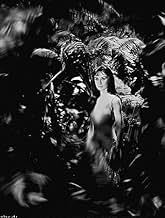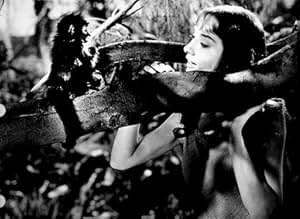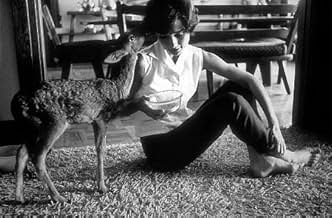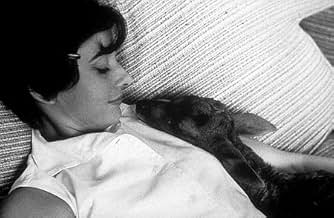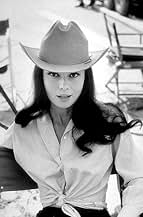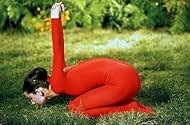Aggiungi una trama nella tua linguaA young man in the jungles of Venezuela meets a strange girl of the forest and falls in love with her.A young man in the jungles of Venezuela meets a strange girl of the forest and falls in love with her.A young man in the jungles of Venezuela meets a strange girl of the forest and falls in love with her.
- Regia
- Sceneggiatura
- Star
- Native Guide
- (non citato nei titoli originali)
- Native Guide
- (non citato nei titoli originali)
Recensioni in evidenza
Rima shows up as a shadowy figure about a half-hour into the film and doesn't speak until about ten minutes later. Leave it to Hepburn to exhibit any sort of conviction in such an impossible role. Looking ethereal if a little too styled and coiffed (even without Givenchy) and sounding entirely too Euro-cosmopolitan, she still exudes Rima's innocence while discovering the darker secrets of her past. The rest of the cast is not as lucky. Anthony Perkins, a year away from "Psycho", is irritatingly unctuous as Abel when he is not simply confounded by his heroic role. His low point has to be the ridiculous scene when he sings a love song to Rima as he strums his guitar. And where exactly did the guitar come from? Familiar character actors show up in the oddest roles. Lee J. Cobb, heavily made up as a cross between Uncle Jesse Duke and Santa Claus, turns in yet another ham-fisted performance as Nuflo, and Henry Silva is cast as another exotic as the ultimately nefarious tribal leader. Nehemiah Persoff has a small bit at the beginning as a greedy trader, while Sessue Hayakawa, of all people, has a mostly silent role as the tribal leader. Adding to the artifice is the obvious use of soundstages and matte shots to replicate the jungle, and the ending is pure Hollywood sappiness. This is a curio for Hepburn fans.
The story is silly and the production cheesy, and it all comes out like made-for-TV, which is a kind-of compliment, since it was released in 1959, which makes it ahead of its time, though, given the quality of made-for-TV, and that people had to buy a ticket to see this thing, that's not much consolation.
It's lush and ripe, and though they claim it's filmed in South America, I can see the familiar landscapes of the backlot and the flora and fauna of the San Diego Zoo. This one is borderline MST3000, so the best way to watch it is stoned.
Now on to the bad points, and where better to begin that Tony Perkins' impossible miscasting in the lead. The lean, intense Perkins was always a masterly potrayer of angst, as Hitchcock discovered the next year. But he was never much of a conventional leading man, and this film, and the following year's "Tall Story," bring this weakness sharply into focus. Someone such as, say, Robert Wagner or Laurence Harvey, would have been far more believeable. They were the right age for the role, and both were under contract to MGM at the time. What were they thinking? Then there's Sessue Hayakawa, still riding high from his "River Kwai" comeback, as the most improbable native chieftan on record. At least he comports himself with his usual innate dignity. Mel Ferrer, Hepburn's husband at the time, was always a fine actor, but never more than an average director. One can invision a William Wyler (busy at the time with "Ben-Hur"), a George Cukor, or a William Dieterle as a far better director for this film. Finally, Dorothy Kingsly's screenplay fails to patch up the several sizable holes in the original W.H. Hudson story, particularly the "Is-she-dead-or-isn't-she?" ending.
In short, you could do worse that this film, but you could do much, much better, too.
MGM spent over one million dollars (a great deal of money in 1959) getting shots of South America to mix in with the main filming done on MGM's back lot. The mixing in of the shots is well done, but it's obvious what was shot at MGM and what were the South American jungle shots. Perkins is the voice of sanity in the film, because whenever the plot threatens to get too wispy, he brings it back down to earth. He has a scene where he serenades Rima with his lovely tenor voice. It was a pity that he was never in a film musical.
If the film has a message it seems to be that true love never dies.
Lo sapevi?
- QuizOne of the first films (if not the first) to be shot using Panavision's Auto Panatar lenses that eliminated what was called "anamorphic mumps" in the wide-screen CinemaScope process where in close-ups an actor's face would widen horizontally. This innovation won Panavision its first Academy Award. Each lens cost $11,000 ($94,000 in 2017).
- BlooperSouth American Indians having driven Rima up a tall tree set it on fire and flames are seen in the tree tops but only the tree and brush at its base burns, not the rest of the forest.
- Citazioni
Abel: [sings to Rima] They say that love is a fragile thing, a linnet's wing / a magic ring made of gold / They say that love is a bird in flight, a gleam of light / a star too bright to behold / Tell me, tell me, tell me, o child of the moon / Is it as they say? Must love slip away too soon? / Tell me, Rima, where are the meadows of June? / Speaking with her eyes, softly she replies: / I know a place where green mansions are, as near or far / As any star up above / And in this land of eternal spring, where hummingbirds can learn to sing / Green grow the mansions of love.
- ConnessioniReferenced in Forecast (1945)
I più visti
Dettagli
- Data di uscita
- Paese di origine
- Lingua
- Celebre anche come
- La flor que no murió
- Luoghi delle riprese
- Kaieteur Falls, Guyana(Background for opening credits)
- Azienda produttrice
- Vedi altri crediti dell’azienda su IMDbPro
Botteghino
- Budget
- 3.288.000 USD (previsto)
- Tempo di esecuzione1 ora 44 minuti
- Proporzioni
- 2.35 : 1
Contribuisci a questa pagina




